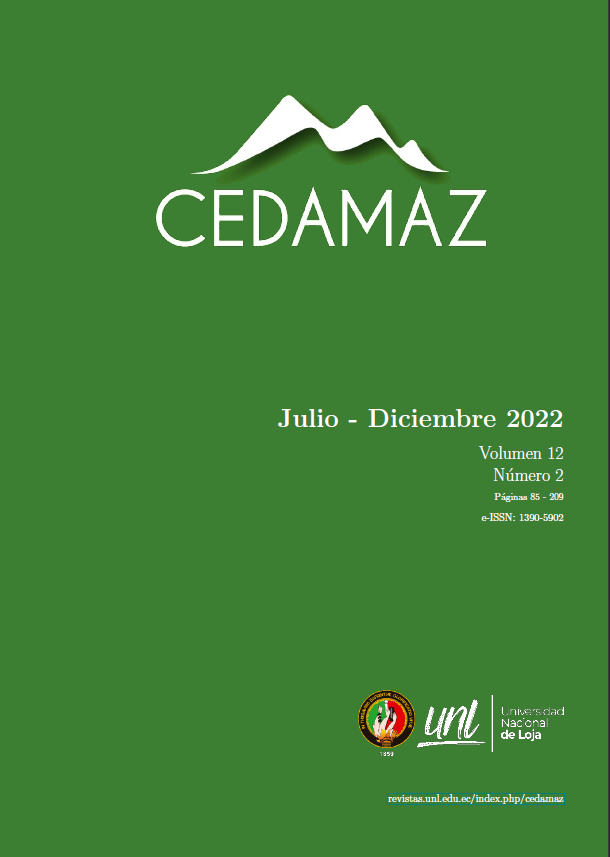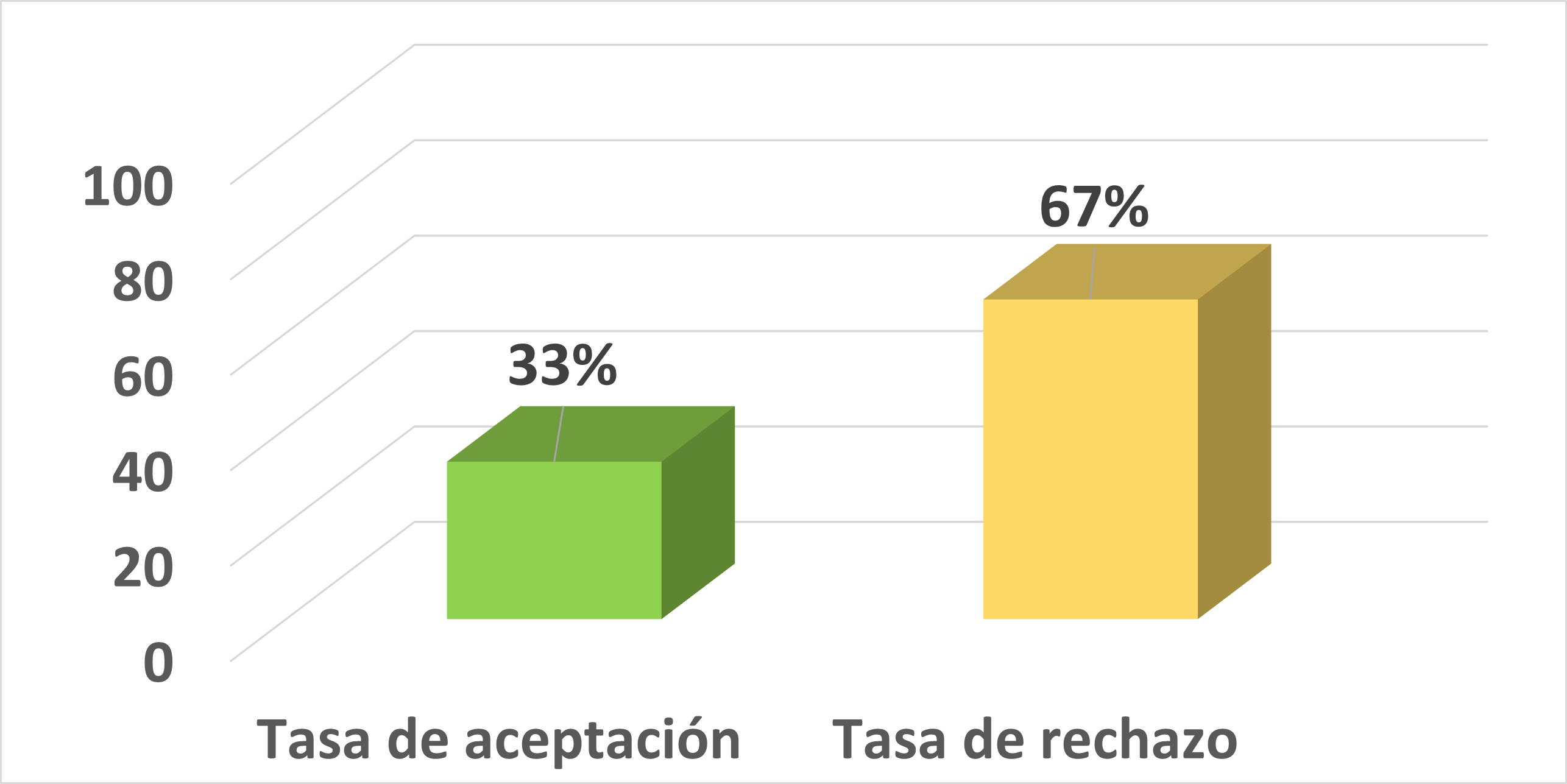Variation of diatoms (Bacillariophyta) in a gradient of the riverbank conservation status of the Malacatos river, Loja- Ecuador
DOI:
https://doi.org/10.54753/cedamaz.v12i2.1626Keywords:
Riparian zone, Periphyton, Epilithic diatoms, Diversity, EquitabilityAbstract
The ecological conditions of Andean rivers determine the health of these ecosystems and, consequently, water quality. A study was carried out in the Malacatos River in Loja canton to determine the influence of the conservation state of the river’s riparian zones on the diversity, richness and productivity of diatom communities, phytoplankton organisms that are used as bioindicators of environmental conditions. Three study zones were defined: a stretch with native riparian vegetation, a zone with disturbed riparian forest (semi-conserved zone) and a stretch without riparian vegetation (urban zone). For each zone, transects were determined in the river, and periphyton samples were taken. The results reported the presence of 21 genera of epilithic diatoms. A moderate diversity and a high evenness of diatom communities was determined in the riparian zone with native and semi-conserved vegetation, in contrast to the urban section that showed a low diversity and evenness with a dominance of few genera (Navicula and Nitzschia). The record of several diatom genera in different environmental gradients determined that the conservation state of riparian vegetation adjacent to the Malacatos River watercourse may influence the richness, composition, diversity and biovolume of diatom communities. Overview, the results showed the state of conservation of riparian vegetation and the anthropogenic activities around the river influenced on diatom ecology and consequently they may affect water quality. In this context, the scientific community agrees on the importance of assessing the ecological integrity of aquatic ecosystems, focusing on biological traits of bioindicator organisms.References
Calizaya, J., Avendaño, M., y Delgado, I. (2013). Evaluación de la calidad del agua fluvial con diatomeas (Bacillariophyceae), una experiencia en Tacna, Perú. Revista Peruana de Medicina Experimental y Salud Pública, 30(1), 58–63. DOI: https://doi.org/10.1590/S1726-46342013000100012
Céspedes, E. (2014). Análisis taxonómico de las principales especies de diatomeas Bacillariophyceae) en seis sitios en la cuenca del río Sarapiquí, Heredia, Costa Rica. En Escuela De Historia: Vol. I.
Chasiquiza, M., y Cola, G. (2017). Determinación del índice trófico de la calidad de agua a partir de la presencia de diatomeas epilíticas en el río Cutuchi sector Parque Nacional Cotopaxi, cantón Latacunga. En Universidad Técnica De Cotopaxi Facultad (Vol. 1).
Chen, X., Bu, Z., Stevenson, M. A., Cao, Y., Zeng, L., y Qin, B. (2016b). Variations in diatom communities at genus and species levels in peatlands (central China) linked to microhabitats and environmental factors. Science of The Total Environment, 568, 137–146. DOI: https://doi.org/10.1016/j.scitotenv.2016.06.015
Chen, X., Zhou, W., Pickett, S., Li, W., Han, L., y Ren, Y. (2016a). Diatoms are better indicators of urban stream conditions: A case study in Beijing, China. Ecological Indicators, 60, 265–274. DOI: https://doi.org/10.1016/j.ecolind.2015.06.039
Chessman, B., Growns, I., Currey, J., y Plunkett-cole, N. (1999). Predicting diatom ommunities at the genus level for the rapid biological assessment of rivers. Freshwater Biology, 41(1999), 317–331. DOI: https://doi.org/10.1046/j.1365-2427.1999.00433.x
Donato, J. (2019). Diversidad de diatomeas en un sistema fluvial andino: los nutrientes y la conductividad como factores de explicación. Revista de la Academia Colombiana de Ciencias Exactas, Físicas y Naturales, 43(169), 728–736. DOI: https://doi.org/10.18257/raccefyn.939
Fetscher, A., Busse, L., Fetscher, A., y Ode, P. (2009). Standard Operating Procedures for Collecting Stream Algae Samples and Associated Physical Habitat and Chemical Data for Ambient Bioassessments in California. En In California State Water Resources Control Board Surface Water Ambient Monitoring Program (SWAMP) Bioassessment SOP, 2.
Flores-Stulzer, E., Villalobos-Sandi-, N., Piedra-Castro, L., y Scholz, C. (2017). Evaluación breve de la presencia de diatomeas y su relación con algunos parámetros físicoquímicos en el río Pirro, Heredia, Costa Rica. Uniciencia, 31(2), 1–11. DOI: https://doi.org/10.15359/ru.31-2.7
Guzman, B., y Leiva, D. (2017). Diatomeas como bioindicadores para la evaluación de la calidad del agua en la cuenca del río Utcubamba, Amazonas - Perú. Revista Científica UNTRM: Ciencias Naturales e Ingeniería, 2(1), 16. DOI: https://doi.org/10.25127/ucni.v2i1.220
Heino, J., y Soininen, J. (2007). Are higher taxa adequate surrogates for species-level assemblage patterns and species richness in stream organisms? Biological Conservation, 137(1), 78–89. DOI: https://doi.org/10.1016/j.biocon.2007.01.017
Higgins, J., Bryer, M., Khoury, M., y Fitzhugh, T. (2005). A Freshwater Classification Approach for Biodiversity Conservation Planning. Conservation Biology, 19(2), 432–445. DOI: https://doi.org/10.1111/j.1523-1739.2005.00504.x
Hillebrand, H., Dürselen, C.-D., Kirschtel, D., Pollingher, U., y Zohary, T. (1999). Biovolume calculation for pelagic and benthic microalgae. Journal of Phycology, 35(2), 403–424. DOI: https://doi.org/10.1046/j.1529-8817.1999.3520403.x
Juggins, S., Kelly, M., Allott, T., Kelly-Quinn, M., y Monteith, D. (2016). A Water framework Directivecompatible metric for assessing acidification in UK and Irish rivers using diatoms. Science of the Total Environment, 568, 671–678. DOI: https://doi.org/10.1016/j.scitotenv.2016.02.163
Loza, S., Benavides, R., Brenes, C., y Ballestero, D. (2018). Estructura del fitoplancton en las épocas seca y lluviosa en el golfo de Papagayo, Costa Rica. Revista Ciencias Marinas y Costeras, 10(2), 9. DOI: https://doi.org/10.15359/revmar.10-2.1
Lozano, S., Vasquez, C., Rivera Rondón, C., Zapata, A., y Ortiz, M. L. (2019). Efecto de la vegetación riparia sobre el fitoperifiton de humedales en la Orinoquía colombiana. Acta Biológica Colombiana, 24(1), 67–85. DOI: https://doi.org/10.15446/abc.v24n1.69086
Steinitz-Kannan, M., y Cooper, J. (2007). The diatoms (Bacillariophyta). New Survey of Clare Island, 6, 115139,200,217-232.
Tinoco-Pérez, L., Salvat, K., Hernández, I., Hernández, M., Mejía, G., y Castro, J. (2019). Water quality study of the Actopan river in the localities of Santa Rosa and La Linda , Veracruz using macroinvertebrates and diatoms as bioindicators. Journal of Entomology and Zoology Studies, 7(1), 146–150.
Maiquiza, K., y Tonato, G. (2020). Identificación de diatomeas epilíticas asociadas a la calidad del agua en el río Yanayacu, sector San Juan, cantón Salcedo, provincia de Cotopaxi, 2020. En Universidad Técnica de Cotopaxi (Vol. 1).
Vélez, A., Lozano, S., y Cáceres, K. (2016). Diversidad De Fitoplancton Como Indicador De Calidad De Agua En La Cuenca Baja Del Río Lurín , Lima , Perú. Ecología Aplicada, 15(2), 1–12. DOI: https://doi.org/10.21704/rea.v15i2.745
Medina, M., Andrade, M., y Poma, M. (2009). Determinación de la calidad del agua del Río Malacatos mediante Fauna Bentónica como bioindicadora y alternativas de mitigación de la contaminación. [Universidad Nacional de Loja].
Wetzel, R. G. (1983). Attached algal-substrata interactions: fact or myth, and when and how? Periphyton of Freshwater Ecosystems, 356. DOI: https://doi.org/10.1007/978-94-009-7293-3_28
Mendes-Santos, S., y Ferragut, C. (2021). Evaluating the periphyton as a bioreactor for removal of nutrients in a shallow hypereutrophic reservoir. Acta Limnologica Brasiliensia, 33. DOI: https://doi.org/10.1590/s2179-975x8920
Mendoza, M., Quevedo, A., Bravo, A., Flores, H., De La Isla De Bauer, M., Gavi, F., y Zamora, B. (2014). Estado ecológico de ríos y vegetación ribereña en el contexto de la nueva ley general de aguas de México. Revista Internacional de Contaminación Ambiental, 30(4), 11–16.
Mengo, L. (2017). Composición taxonómica y riqueza de diatomeas en el Río Suquía, Córdoba (Argentina). 4(2), 55–62.
Molina, J. (2019). Caracterización de comunidades diatomeas epilíticas del río Carihuaycu para la identificación de especies bioindicadoras de eutrofización. En Universidad Internacional SEK (Vol. 6, Número 1).
Montoya-Moreno, Y., y Aguirre, N. (2013). Estado del arte del conocimiento sobre perifiton en Colombia. Gestión y ambiente, 16(3), 91–117.
Nhiwatiwa, T., Dalu, T., y Sithole, T. (2017). Assessment of river quality in a subtropical Austral river system: a combined approach using benthic diatoms and macroinvertebrates. Applied Water Science, 7(8), 4785–4792. DOI: https://doi.org/10.1007/s13201-017-0599-0
Ortiz, M. (2015). Caracterización de diatomeas como herramienta para el estudio de la calidad del agua del río Teaone. En Pontificia Universidad Católica del Ecuador. (Vol. 13, Número 3).
Pandey, L. K., Lavoie, I., Morin, S., Park, J., Lyu, J., Choi, S., Lee, H., y Han, T. (2018). River water quality assessment based on a multi-descriptor approach including chemistry, diatom assemblage structure, and non-taxonomical diatom metrics. Ecological Indicators, 84(March 2017), 140–151. DOI: https://doi.org/10.1016/j.ecolind.2017.07.043
Ponader, K. C., y Potapova, M. G. (2007). Diatoms from the genus Achnanthidium in flowing waters of the Appalachian Mountains (North America): Ecology, distribution and taxonomic notes. Limnologica, 37(3), 227–241. DOI: https://doi.org/10.1016/j.limno.2007.01.004
Sabater, S., Sabater, F., y Tomas, X. (1987). Water quality and diatom communities in two catalan rivers (N.E. Spain). Water Research, 21(8), 901–911. DOI: https://doi.org/10.1016/S0043-1354(87)80007-6
Segura, V., Almanza, J., y Ponce, J. (2016). Diversidad en comunidades de diatomeas epilíticas con relación a los parámetros fisicoquímicos en la cabecera del río Zinapécuaro, México. Hidrobiológica, 26(2), 187–202. DOI: https://doi.org/10.24275/uam/izt/dcbs/hidro/2016v26n2/Segura
Published
How to Cite
Issue
Section
License
Copyright (c) 2022 CEDAMAZ

This work is licensed under a Creative Commons Attribution-NonCommercial-NoDerivatives 4.0 International License.
Those authors who have publications with this journal, accept the following terms:
- After the scientific article is accepted for publication, the author agrees to transfer the rights of the first publication to the CEDAMAZ Journal, but the authors retain the copyright. The total or partial reproduction of the published texts is allowed as long as it is not for profit. When the total or partial reproduction of scientific articles accepted and published in the CEDAMAZ Journal is carried out, the complete source and the electronic address of the publication must be cited.
- Scientific articles accepted and published in the CEDAMAZ journal may be deposited by the authors in their entirety in any repository without commercial purposes.
- Authors should not distribute accepted scientific articles that have not yet been officially published by CEDAMAZ. Failure to comply with this rule will result in the rejection of the scientific article.
- The publication of your work will be simultaneously subject to the Attribution-NonCommercial-NoDerivatives 4.0 International (CC BY-NC-ND 4.0)









